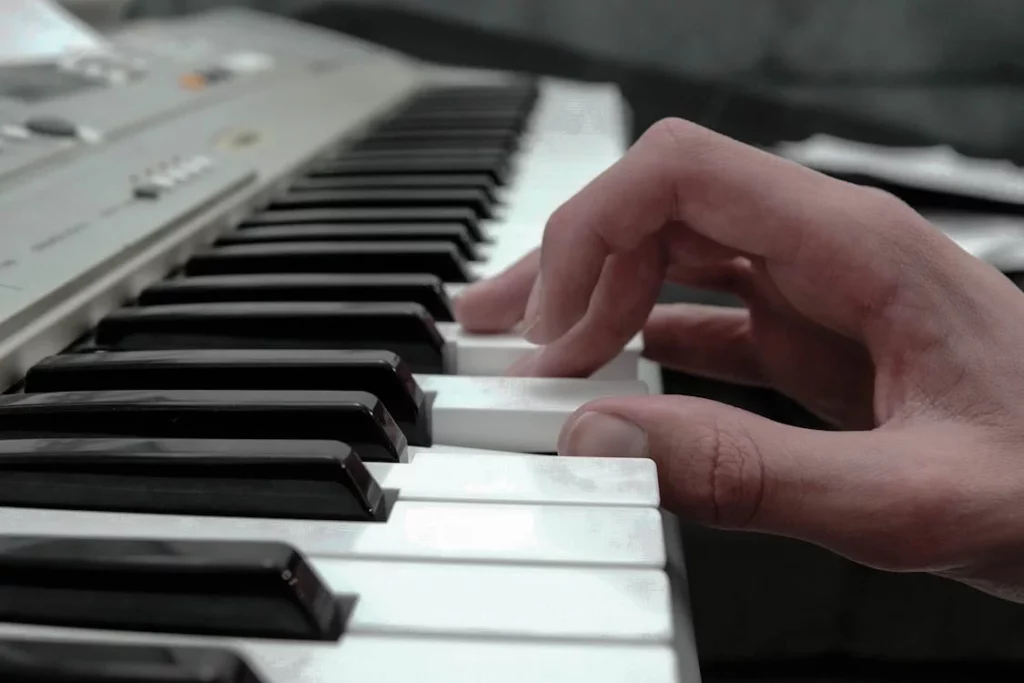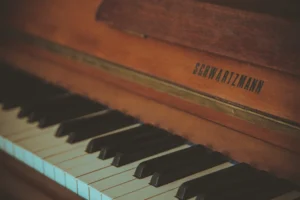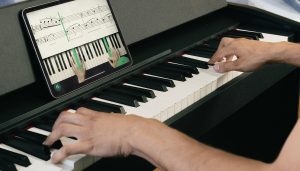Music phrasing is among the most important, yet most often overlooked, aspects of developing as a musician. Musical phrasing impacts every facet of music, and is particularly important for conveying the correct emotional depth and nuance of a composition.
Yet, among beginning piano students, phrasing in music is a secondary concern. In this comprehensive article, we will delve into the essence of music phrasing, explore its various components, and understand its significance in musical performance and appreciation.
- Fall in love with the music - Learn your favorite songs, at a level suitable for you.
- Enjoy interactive piano lessons - Explore courses covering music theory, technique chords & more.
- Get real-time feedback - Skoove's feedback tells you what went well and what needs practice.

Understanding music phrasing
Imagine listening to a piece of music that feels flat and monotonous, lacking in dynamics and emotional depth. Now, contrast that with a performance that breathes life into each note, creating a vivid and engaging journey for the listener. The difference between these two experiences often lies in the art of music phrasing.
Music phrasing is akin to the punctuation and intonation in speech, guiding the listener through the musical narrative with clarity and emotion.
So, exactly what is musical phrase?
Phrasing in music refers to the way a musician shapes a sequence of notes in a passage of music to convey expression, emotion, and musical intent. It involves the manipulation of elements such as melody, rhythm, dynamics, and articulation to create a sense of direction and coherence.
Just as a speaker uses pauses, emphasis, and intonation to communicate effectively, a musician uses phrasing to bring out the character and meaning of the music. Phrasing is one of the most important components of learning how to play piano.
What is phrase in music?
A phrase in music is a self-contained musical thought, similar to a sentence in language. It typically consists of a series of notes from piano scales that form a recognizable unit, with a clear beginning, middle, and end.
Phrases can vary in length and complexity, but they generally aim to convey a complete idea or emotion.
In Western classical music, phrases often correspond to measures of music and can be identified by cadences, which mark the end of a phrase and provide a sense of resolution.
The importance of music phrasing
Let’s explore some ways that music phrasing can impact the performance of a piece of music.
Emotional impact
Music phrasing, along with other musical parameters like key signatures, is fundamental in shaping the emotional resonance of a performance. Musicians can highlight the emotional arc of a piece, create tension and release, and communicate the narrative of a composition all by incorporating strong music phrasing.
Well-executed phrasing can transform a technically proficient performance into an emotionally compelling one, resonating deeply with the audience.
Interpretation and expression
By focusing on phrasing, musicians can interpret and express music in their own personal and unique way. No two performances, even from the same performer, will be alike. By paying attention to phrasing, musicians can bring out subtle nuances, emphasize important musical elements, and convey their interpretation of the composer’s intent.
Communication with the audience
Powerful phrasing opens the channel of communication between the musician and the audience. It helps listeners to comprehend the structure and flow of the music, which makes for a much more effective performance.
Just as a well-delivered speech keeps the audience engaged, well-phrased music captures the listener’s attention and guides them through the musical journey.
Comparison with language
Music phrasing is strongly correlated to spoken language. Both make use of pauses, emphasis, and inflection to convey emotion and meaning.
In music, phrasing helps to create a sense of conversation, with musical ideas flowing naturally and expressively. Understanding these similarities can help musicians approach phrasing with a deeper awareness of its communicative power.
Components of musical phrasing
Now let’s explore four main components of musical phrasing so that you can start to incorporate more advanced phrasing into your piano performances.
1. Melody
The melody is often the most prominent aspect of a musical phrase and the most identifiable.
Effective phrasing of the melody involves shaping its contour, emphasizing key notes, and creating a sense of direction and purpose. Musicians use techniques such as legato (smooth, connected notes) and staccato (short, detached notes) to shape the melodic line.
2. Rhythm
Rhythm is the timing and duration of notes within a phrase. It gives music its sense of movement and pulse. Phrasing the rhythm involves creating variations in timing, such as slight accelerations or decelerations, to add expressiveness.
Musicians often use rubato, a technique that involves flexible tempo, to enhance the emotional impact of a phrase.
3. Dynamics
Dynamics refer to the volume and intensity of the music. They play a significant role in phrasing by providing contrast and emphasis.
Crescendos (gradual increases in volume) and decrescendos (gradual decreases in volume) are common dynamic techniques used to shape a phrase. Effective use of dynamics helps to highlight important musical moments and create a sense of drama.
4. Articulation
Articulation involves how notes are played, including their attack, sustain, and release. Different articulation techniques, such as legato, staccato, and accents, contribute to the character of a phrase.
Musicians use articulation to add variety and texture to their playing, enhancing the expressiveness of the music.
Historical context
The concept of phrasing has evolved significantly over the course of musical history. In the Baroque period (1600-1750), phrasing was closely tied to the principles of rhetoric, with musicians aiming to imitate the expressive qualities of speech. Composers like Johann Sebastian Bach emphasized clear articulation and expressive ornamentation in their music.
During the Classical period (1750-1820), composers such as Wolfgang Amadeus Mozart and Ludwig van Beethoven focused on balance, clarity, and proportion in their phrasing. Phrases became more symmetrical, and the use of dynamics and articulation to shape musical ideas was refined.
The Romantic period (1820-1900) brought a heightened emphasis on emotional expression and individuality. Composers like Franz Schubert and Johannes Brahms used more elaborate phrasing to convey deep emotions and complex narratives. The concept of rubato became more prominent, allowing for greater flexibility in tempo and phrasing.
In the 20th century and beyond, phrasing continued to evolve with the advent of new musical styles and technologies. Jazz musicians, for example, developed unique phrasing techniques, such as syncopation and swing, to create a distinctive rhythmic feel.
Contemporary composers and performers explore a wide range of phrasing possibilities, pushing the boundaries of musical expression.
The anatomy of a musical phrase
A musical phrase typically consists of three main parts: the beginning, the middle, and the end. Understanding this structure helps musicians to shape their phrasing effectively.
- Beginning: The beginning of a phrase introduces the musical idea. It sets the tone and direction for the rest of the phrase. Musicians often emphasize the initial notes to capture the listener’s attention and establish the phrase’s character.
- Middle: The middle of a phrase develops the musical idea introduced at the beginning. It can involve variations, repetitions, and contrasts. Effective phrasing in this section involves maintaining a sense of direction and coherence.
- End: The end of a phrase provides resolution and closure. It often coincides with a cadence, a harmonic progression of piano chords that signals the end of a musical thought. Musicians use various techniques, such as dynamic changes and ritardando (gradual slowing down), to create a satisfying conclusion to the phrase.
Examples from different genres
Phrasing techniques vary widely across different musical genres. Let’s take a look at various characteristic phrasing styles across genres.
Classical
In classical music, phrasing is often closely tied to the structure of the music. For instance, in a Mozart piano sonata, the phrasing helps to articulate the formal divisions of the piece, such as the exposition, development, and recapitulation.
Musicians use dynamics, articulation, and tempo changes to bring out the character of each phrase.
Jazz
Jazz musicians use phrasing to create a distinctive rhythmic feel. Syncopation, swing, and improvisation are key elements of jazz phrasing.
For example, in a jazz solo, the musician might use rhythmic variations and dynamic contrasts to create an engaging and spontaneous performance.
Pop and Rock
In pop and rock music, phrasing is often used to highlight the lyrics and enhance the emotional impact of the song.
Singers use techniques such as vibrato, dynamic changes, and breath control to shape their phrases. Instrumentalists, like guitarists, use bends, slides, and articulation to add expressiveness to their solos.
Techniques for effective music phrasing
Here are a few expert-recommended techniques you can use to improve on music phrasing:
1. Dynamic contrast
Dynamic contrast involves varying the volume and intensity of the music to create expressive phrasing. Musicians use crescendos, decrescendos, and sudden dynamic changes to highlight important musical moments.
For instance, a gradual crescendo can build anticipation and excitement, while a sudden piano (soft) can create a moment of intimacy and reflection.
2. Tempo and rhythm
Tempo and rhythm are essential components of phrasing. Musicians often use rubato, a technique that involves flexible tempo, to enhance the expressiveness of a phrase. Slight accelerations and decelerations can add emotional depth and drama to the music.
Additionally, many musicians use rhythmic phrasing to emphasize certain beats or syncopate rhythms to create interest and variety.
3. Expressive techniques
Various expressive techniques can enhance music phrasing, adding depth and nuance to the performance. These techniques include:
- Vibrato: A slight fluctuation in pitch that adds warmth and intensity to a note.
- Portamento: A smooth, sliding transition between notes, often used by vocalists and string players.
- Glissando: A rapid slide through a series of pitches, creating a dramatic effect.
- Crescendo and Decrescendo: Gradual increases and decreases in volume to shape the musical line.
How to improve your music phrasing
Improving music phrasing requires practice, analysis, and feedback. Let’s check out some strategies you can use today to start improving your musical phrasing immediately.
Listening and analysis
Listening to great performances and analyzing the phrasing techniques used by master musicians can provide valuable insights. Pay attention to how phrasing shapes the overall musical experience and try to identify specific techniques that contribute to expressive playing.
For example, listen to recordings of renowned pianists like Arthur Rubinstein or vocalists like Maria Callas to understand how they use phrasing to convey emotion and meaning.
Practice techniques
Practice is essential for developing effective phrasing. Try out some of the following practice techniques with your favorite easy piano songs!
Phrase segmentation
Break down a piece into smaller phrases and practice shaping each one individually. Focus on the beginning, middle, and end of each phrase to create a coherent and expressive musical idea. This is also a great strategy to help remember the notes of any piano song.
Dynamic variations
Practice playing phrases with different dynamic levels to explore the impact of volume on expressiveness. Experiment with crescendos, decrescendos, and sudden dynamic changes to add contrast and interest.
Rubato practice
Incorporate rubato into your practice to develop a sense of flexible timing. Experiment with slight tempo changes to enhance the emotional impact of a phrase.
Feedback and iteration
Seeking feedback from teachers, peers, and mentors is crucial for improving phrasing. Perform in front of others and ask for constructive criticism on your phrasing techniques.
Recording your practice sessions and listening back can also help identify areas for improvement. Based on the feedback you receive, continuously iterate and refine your phrasing.
In the YouTube video below, David Hartley explains how music phrasing functions similarly to punctuation in language, guiding listeners through musical ideas with clarity and expression.
Drawing parallels to written text, where punctuation marks delineate thoughts and enhance readability, the video demonstrates how musical phrases, like sentences, are structured with beginnings, middles, and ends.
Using the example of the piece “Jasmine Flower,” the narrator highlights how rests at the end of phrases create clarity and emphasize musical ideas. The video also emphasizes the importance of thoughtful phrasing in enhancing musical communication and engaging listeners effectively.
Skoove: a valuable tool for improving phrasing
Skoove, a piano learning platform, offers valuable resources and exercises to help musicians improve their phrasing.
With interactive online lessons, personalized feedback, and a vast library of music, Skoove provides a comprehensive learning experience. The platform’s emphasis on musical expression and phrasing makes it an excellent tool for musicians looking to enhance their skills.
Music is all about phrasing!
Music phrasing is what makes a flat performance into something magical and memorable for the audience! By enhancing the emotional impact of a piece, shaping the contours and peaks with expressive dynamics, articulations, and more you can convey any emotional quality you like and make a more meaningful connection with the audience!
By mastering the art of phrasing and building solid piano fundamentals with a learning app like Skoove, you can take your piano performances to the next level and bring out the master musician inside of you!
Author of this blog post:
Susana Pérez Posada

With over seven years of piano education and a deep passion for music therapy, Susana brings a unique blend of expertise to Skoove. A graduate in Music Therapy from SRH Hochschule Heidelberg and an experienced classical pianist from Universidad EAFIT, she infuses her teaching with a holistic approach that transcends traditional piano lessons. Susana’s writings for Skoove combine her rich musical knowledge with engaging storytelling, enriching the learning experience for pianists of all levels. Away from the piano, she loves exploring new places and immersing herself in a good book, believing these diverse experiences enhance her creative teaching style.
Published by Lydia Hovan from the Skoove team














